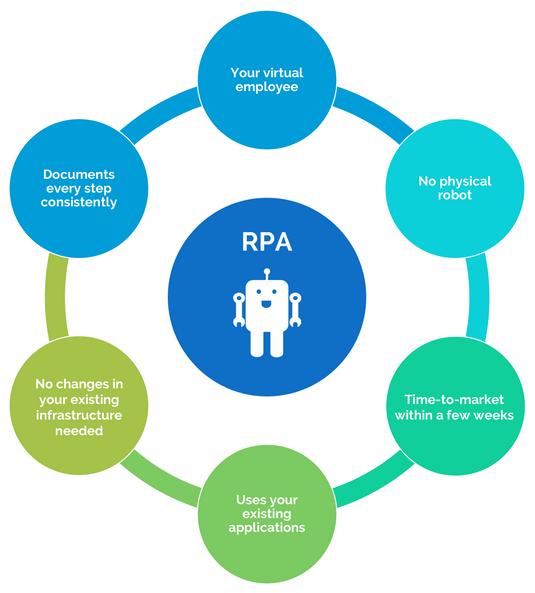Robotic Process Automation (RPA)
What is Robotic Process Automation (RPA)
The term “robot” is metaphorical, referring to software products which provide a generic automation capability and are configured within the end-user environment to execute manual and repetitive tasks.
Robotic Process Automation (RPA) is to configure, require limited IT expertise and can quickly be ‘trained’ and deployed to automate manual tasks. RPA differ from traditional software by working at the user interface level, replicating the exact actions a human user would take, in fact creating a digital workforce for your front office, back office and support tasks.
RPA does not replace existing company software but instead takes advantage of existing applications. Robotic automation does not compete with Business Process Management Systems (BPMS) or Service Oriented Architecture (SOA) initiatives but rather extends and complements them.
RPA software is composed of multiple components. First, for collection, they employ a variety of tools for grabbing digital data, which can include screen scraping, digital image recognition, or the ability to access a server or be linked to a website. They also make use of rule engines similar to those found in business process management tools.
RPA distinguishes from traditional IT automation by the RPA ability to be aware and adapt to changing circumstances, exceptions and new situations. Once RPA software has been trained to capture and interpret the actions of specific processes in existing software applications, it can manipulate data, trigger responses, initiate new actions and communicate with other systems autonomously. Large and small companies will be able to benefit from RPA by expediting back-office and middle-office tasks in a wide range of industries, including insurance, finance, procurement, Supply Chain Management (SCM), accounting, Customer Relationship Management (CRM) and Human Resource Management (HRM).
RPA software is expecially useful for organizations that have many different, complicated systems that need to interact together fluidly. For example, if an electronic form from a human resource system is lacking a zip code, traditional automation software would flag the form as having an exception and an employee would handle the exception by looking up the correct zip code and enter it in the form. Only when the form is complete, the employee can send it to be entered into the organization's payroll system. With RPA technology, however, software that has the ability to adapt, self-learn, and self-correct would handle the exception and interact with the payroll system without human assistance.
The benefits of RPA solutions
- Quick return of investment
- Increased and consistent quality
- Allows time to innovate, develop and focus on customer satisfaction
- Decreased cycle times and improved throughput
- Reduce errors while greatly increasing efficiency
- Flexibility and scalability
- Round-the-clock availability
- Faster processing
- Better utilization on employee know-how
RPA can be used to automate processes that are
- Digital
- Time critical and seasonal
- Highly repetitive
- Prone to error
- Rule based

By definition – what is needed to implement RPA?
The idea with RPA is that you use existing or similar computer as the employee. This means that the same software that the employee uses is there with the same security settings. The RPA software is installed on the same computer. After installing it you need to learn it to perform the same tasks as the employee do it - record a scenario that can be later be played back at a higher speed.
VisualCron and RPA
Before the definition of RPA became commonly used VisualCron automated desktops through the Desktop Macro Task. From version 8.2.0 the Web Macro Recorder Task was implemented and gave support for automating browsers as well. Together, these Tasks form the "Foreground automation" Tasks (RPA in other words) while still offering powerful "Background automation" Tasks.
While the idea about RPA is great it is not always the fastest, complete or most powerful solution. Sometimes you need to combine foreground automation with background automation. For example, peforming some manual Tasks in an application might result in many files created that you may want to upload to a remote SFTP server. The number of files may vary. If this was only dependent on RPA technology it would be hard to make a repeatable process selecting the files created and do something about it. If you combined this with File Triggers (waiting for new files from an application) or by a file filter (only selecting new files). Not only does this combination handle all files but also you have complete control of which files were created and are able to reuse this data – for example sending you an email with all files created – something that would be very hard using only RPA technology.
